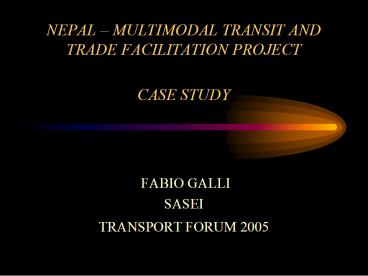NEPAL MULTIMODAL TRANSIT AND TRADE FACILITATION PROJECT CASE STUDY - PowerPoint PPT Presentation
1 / 14
Title:
NEPAL MULTIMODAL TRANSIT AND TRADE FACILITATION PROJECT CASE STUDY
Description:
Nepal's remote and landlocked geographical location, sandwiched between China ... Without a negotiated Nepal-India Rail Service Agreement, leasing out of the ICD ... – PowerPoint PPT presentation
Number of Views:259
Avg rating:3.0/5.0
Title: NEPAL MULTIMODAL TRANSIT AND TRADE FACILITATION PROJECT CASE STUDY
1
NEPAL MULTIMODAL TRANSIT AND TRADE FACILITATION
PROJECTCASE STUDY
- FABIO GALLI
- SASEI
- TRANSPORT FORUM 2005
2
PROJECT GENESIS
- Nepals remote and landlocked geographical
location, sandwiched between China and India, has
been a major cause limiting its economic
development.
3
(No Transcript)
4
PROJECT GENESIS
- Poor transport infrastructure cumbersome
customs procedures have caused - Very high transport costs
- Substantial pilferage loss
- Unreliable and slow movement of import/export
goods - Trade diversion and smuggling
5
PROJECT GENESIS
- To improve trade competitiveness, Nepal
- negotiated an improved India-Nepal Trade
Transit Treaty, and - planned a set of integrated transport
infrastructure improvements (road, customs and
dry port facilities) on its side of the
Nepal-India transit corridor.
6
PROJECT OBJECTIVES
- Project Development Objectives (PDO)
- Reduce import and export transport costs
- Streamline transit and trade procedures
7
PROJECT COMPONENTS
- Construction of new road/rail Inland Container
Depot (ICD) near Birgunj - Reconstruction of existing road only ICD at
Biratnagar and Bhairahawa - Construction of railway spur from Raxaul (India)
to Birgunj (Nepal)
8
PROJECT COMPONENTS
- TA for trade facilitation
- Installation of Automated Systems for Customs
Data (ASYCUDA) at Birgunj, Biratnagar
Bhairahawa - Installation of Advanced Cargo Information System
(ACIS) at Birgunj, Biratnagar Bhairahawa
9
PROJECT COST DURATION
- Total project cost estimated at US28.5 million
(actual cost US21.4 million) - Implementation period was supposed to be about 4
(four) years starting from early 1998 to end-2001
(actual time 5.5 years)
10
EXPECTED PROJECT BENEFITS
- Lower transport costs on the 1000 km transport
corridors between Nepal and Kolkatta - More efficient customs procedures
- Connection to Indian Railways rail network
- Less pilferage damage to cargo
- More reliable secure carriage of goods
- Private sector development through leasing out of
three facilities - Safer more environmentally sustainable carriage
of goods
11
WHAT WAS ACHIEVED AT PROJECT CLOSURE
- Reconstruction/construction of the ICDs
ancillary infrastructure to a reasonable
standard, on time below budget - Introduction of Single Administrative Document
(SAD) ASYCUDA - Rolling out of a scaled down version of ACIS
- Leasing out of the improved ICDs at Bhairahawa
Biratnagar to the private sector - Streamlining of some of the transit procedures
(i.e., intro of one time lock for containers)
12
WHAT WAS NOT ACHIEVED AT PROJECT CLOSURE
- Leasing out of the ICD at Birgunj to the private
sector was not completed - The Railway, Carriage of Goods by Road,
Multimodal Transport and Marine Insurance Acts
were not enacted
13
WHY WERE THE PROJECT PDOs NOT FULLY ACHIEVED
- It took over 3 years to negotiate a Nepal-India
Rail Service Agreement to enable train services
to operate into the ICD at Birgunj - Without a negotiated Nepal-India Rail Service
Agreement, leasing out of the ICD at Birgunj
could not be completed by end of project - Delays in finalizing the Nepal-India Rail Service
Agreement resulted in a 3.5 years gap between the
completion of the ICD at Birgunj and its actual
operation
14
LESSONS LEARNED
- Regional transit corridor projects require solid
upfront and continued commitment by
countries/parties involved - There needs to be a high degree of symmetry in
the perceived benefits by all countries/parties
involved in a regional transit corridor project - Better sequencing of physical (civil works) with
non-civil works components is essential to avoid
initial underutilization of assets

